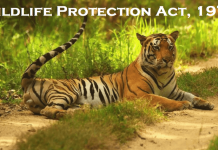This article is written by Pratishtha Mandal, currently pursuing LLB from Campus Law Centre (Law faculty, Delhi University). In this article, she is going to talk about Prevention and Detection measures that have been taken by the government under The Wildlife Prevention Act (1972). Succeeding a very brief introduction to the Act, this Article highlights and provides the basic ideas related to some of the important judicial decisions which have a significance on the offences took place under the Act and the application of the Act.
Table of Contents
Introduction
Wildlife crimes talk about any activities which deal with causing pain and suffering to animals and plants which further puts them closer to extinction and are against the legislation protecting wildlife.
Wildlife crimes are affected by many different ways. Wildlife crimes have been spiralling to the point where animals are killed in mass, not just for food or clothing but also because of ornamental gains, traditional medicine and expression of status symbol. The huge amount of financial advantages and perks involved in wildlife trafficking allows criminal networks to take advantage of resources and thus making it a resources-scarce state. The illegal wildlife trade also brings in the attention of the government to prevent wildlife from being exploited through such illegal trade practices, which refers to crimes which are associated with live wildlife, wildlife products or their extracts, both flora and fauna, across the world.
Who all are involved in Wildlife Crime:
- Professionals- Poachers, transporters, middlemen, smugglers, pharmacies and other end users linked with bigger mafia groups.
- Opportunists- small-time criminals tempted by high profits and low risks, people who act as helpers at the scene of crime.
- Little investigated groups- Parthies, Bagadias, Tibetan settlements and Tibetan medicines.
- Politicians- Political aid in promoting illegal export and import of wildlife.
How a forest officer is prepared with no formal training to cope and coordinate with criminal organisations:
- Required to get training during the service on the field.
- There should be access of knowledge regarding the wildlife crimes to higher officers in prevention, detection and investigation to quote a few.
Prevention and Detection of offences
Prevention- As a major strategy in the fight against wildlife crime, it is important to identify and interpret early warning signs. These signs can be read by most field staff if they have the tendency for it and spend sufficient time in the field.
Section 50 of the Wildlife Protection Act grants power to entry, search and arrest, but the procedure is prescribed under Section 100 of Code of Criminal Procedure, 1973.
Detection- It is important and requisite to identify the wildlife crimes as to prevent them from happening again in future, which includes:
- Technical knowledge of identifying wildlife and animal parts.
- Important animals and animal parts in trade.
- Communities involved in wildlife crime, their cultural habits and their links and association with crime mafias.
- Knowledge of wildlife poaching techniques.
- Changes in their lifestyle.
- Whether databases of these people are made/updated and circulated to the concerned.
- Whether proper training has been imported to all the cutting edge staff.
- Who is responsible for what? Whether proper directions have been issued or not.
- Whether migratory routes of these have been identified or not.
- Whether local markets are being listed and checked regularly.
- Whether on foot patrolling is being planned and conducted and its effectiveness monitored.
- Whether proper staff at all levels is equipped or not.
- Whether staff has been properly trained in intelligence gathering or not.
- Whether staff has been properly trained in legal aspects of investigation and case processing or not.
- Whether the department is able to penetrate the local criminal network of small illegal trade of animals, animal derivatives, killing and hunting of animals etc,. or not.
All these points and aspects will matter and help us in preventing wildlife crimes effectively and in a judicial manner.
Wildlife Protection Act
The Wildlife Protection Act, 1972, is the parent legislation in the country for wildlife crime administration.
The Wild Life Protection Act was sanctioned in 1972 and has been amended six times, the last amendment took place in 2006. With over forty years of being mentioned in the statute book, the interpretation and understanding of the Act has been intensified because of decisions of High Courts and the Supreme Court. Yet there still exists some unanswered questions and grey areas within the law. The Act is generally characterised as a very strong codification of law for wildlife protection within India. However, there still remains the questions about its level of implementation and execution.

Constitutional Provisions for the Wildlife Act
By adding Article 48A of the Constitution of India, protection and safeguarding of wildlife and environment was made a duty through 42nd Amendment in 1976.
In Article 51A certain fundamental duties have been mentioned for the people of India to perform. One of the most important duties is to protect and improve the environment and make it available for the future generation which includes lakes, forests, rivers and wildlife and to have compassion for living organisms.
Evolution and Development of the notion of Wildlife Protection in India
India is blessed with a massive variety of natural resources in its rich animal and plant heritage. Wildlife is one of the basic and natural resources that provides the needs and desires of civilization before and today. Therefore, these resources must be conserved, preserved and protected for the survival of mankind. Now let us talk about the historical development of wildlife protection in India in different periods.
Powers granted for Prevention and Detection
- According to the Section 54 of the Wildlife Protection Act, the central government may by the information from the parliament can authorise the Director of Wildlife preservation or any other officer not beneath the rank of Assistant Director of Wildlife Preservation to accept payment of a sum of money by way of compensation of the offence done by that person, which such person have suspected to have committed.
- In the case of a State government in same way, it empowers the Chief Wildlife Warden or any other officer of a rank not below the rank of a Deputy Conservator of Forest, to take payment of a sum of money by the way of composition of offence which a person has done or suspected to have committed or where a reasonable suspicion exists that the person has committed an offence against or under the Wildlife Protection Act
- By paying the composition with regard to the offence made by a person against provisions of the Wildlife Protection Act, such suspected person if in custody can get a release from the custody and no further proceedings will be laid upon against that person for the following offence.
- The officer on compounding of any offence has the power to order the cancellation of any license or grant permit under the Wildlife Protection Act to the offender of provisions under Act. If an officer is not capable enough to do so, he may approach an officer who is authorised, for the cancellation of license or permit of the offender.
- The sum of money taken or accepted or agreed to be accepted as the composition against the offence done by any person against the provisions of the Act under sub-section (1) shall not exceed the sum of twenty-five thousand rupees, as long as that offence, for which a minimum period of imprisonment is prescribed in Section 51, shall be compounded.
Authorities Constituted Under Wildlife (Protection) Act
According to Section 3 of this Act, the Central Government may appoint a Director of Wildlife Preservation, Assistant Directors of Wildlife Preservation and such other officers and employees whenever necessary and required. According to Section 4, the State Government under the said Act can appoint Chief Wildlife Warden, Wildlife Warden, Honorary Wildlife Wardens and other officers and employees if necessary. As per Section 6 the State Governments and the Administrators in Union Territories could organise a Wildlife Advisory Board.
Duties of Wildlife Advisory Board (Section 8)
The Wildlife Advisory Board mainly originated to guide the state government in the following matters:
- In the selection process of areas which can be signified as Sanctuaries, National Parks and Closed areas and the administration.
- In organisation of the policy and provisions for the protection and conservation of wildlife and specified plants.
- In any matter regarding to the amendment of any schedule;
- In relation with the measure to be taken for coordinating with the basic requirements of the tribal peoples and other dwellers of the forests with the protection and conservation of wildlife;
- In any other matter which is directly related to the protection of wildlife which may be mentioned to it by the state government.
Penalties under the Act
Section 51 of the Act sets out the penalties for the violation of its provisions. Penalties vary depending on: a) the Schedule of the animal(s) to which the offence relates; b) the area to which the offence relates (National Park, sanctuary, tiger reserve, core area of tiger reserve); c) the nature of the offence (hunting/altering the boundaries/ other offence); and d) whether the accused is a repeat offender.
- Minimum punishment prescribed under Section 51 of Wildlife Protection Act (1972), specifies minimum punishments for certain periods. However, it has been noticed that some of the courts are granting punishment less than the minimum punishment specified. Re-Examination should be led against such orders. Judicial officers should also be sensible and aware about the minimum punishment prescribed.
- Under Section 51(2): – When a person is convicted of an offence under the Wild Life Protection Act (1972), the court in which the trial is being done related to the offence could order that any captive animal or derivative, in relation of which an offence has been taken place and any trap, tool, vehicle, vessel or weapon used in the commission of such offence should be surrendered to the State Government. The above section also highlights the point that surrender of the property involved in the offence, is to be done only after conviction of the accused by the trial court. Surrender of property mentioned under Section 51(2) of the Act is not the same as surrendering of property obtained from illegal hunting and trade under Chapter VIA of the Wildlife Protection Act.
- Under Section 57 of Wildlife Protection Act (1972) in certain cases: – if it is established that a person is in possession, custody or control of any captive animal, it could be supposed that such person is in unofficial ownership or custody of that animal. However, it is also to be borne in mind that even with shifting of burden to the person guilty, the primary liability to prove the case beyond reasonable doubt will still be resting on the prosecution.
- Surrender of property obtained from illegal hunting and trade as mentioned under Chapter VIA is applicable in cases where the person has been convicted of an offence which is punishable with imprisonment for a term of three years or more.
One of the issues concerned with the punishment granted by the courts sometimes are granted less than the minimum punishment for the offence despite finding the accused guilty.
- State of Uttarakhand v. Akbar Ali Ansari, (2007): in this case, there was a seizure of five unlicensed leopard skins, and the accused was convicted for the same by a Magistrate for One year, three months imprisonment but the minimum sentence for the offence according to law is three years.
- State of Uttarakhand v. Rampal and Harish (2006): in this case, there was a seizure of two unlicensed leopard skins, the Magistrate convicted the accused for five months, and one and a half months imprisonment but the minimum sentence for the offence is three years.
Cognizance of offences
No court could take cognizance of any offence in opposition to the Wildlife Protection Act except on a complaint by The Director of Wildlife Preservation or any other officer authorised in account of the Central Government or The Chief Wildlife Warden or any other officer authorised by the State Government, or any other person who has got a notice of not less than 60 days, in the manner advised, of the supposed offence and of his intention to make complaint to the Central Government ot the State Government or the officer approved as mentioned above.
Important cases:
- Moti Lal v. Central Bureau of Investigation and Another (2002) The provisions mentioned under CrPC are generally relevant to the investigation and trial of wildlife crimes and offences if not especially opposed by the Act.
- Ashwini Kumar Bhardwaj v. State of Rajasthan (2002) The High Court of Rajasthan repealed the legal proceedings in a case in which challan has been filed against the officer who has not especially been permitted to file the complaint for wildlife offences.
- S. Bylaiah v. State by Bannerghatta Police (2008) The Karnataka High Court revoked the legal proceedings in a case regarding which the complaint had already been filed by the police, but not by the officer of the rank specified by the State Government according to the notification.
Presumption to be made in certain cases
- State of Maharashtra v. Gajanan D Jambhulkar (2002) The court struck down the decision of order made by a Judicial Magistrate allowing release of a jeep to its owner, when it was claimed to have been used in the commision of an offence against the provisions under Wildlife Protection Act.
High Court held that- Before the court allow the application of the accused for releasing his vehicle, the courts are required to provide with the sound and appropriate reason to justify such release of vehicle, to possibly exclude such vehicle to act as an evidence that will be liable for forfeiture according to Section 51 of the Wildlife Protection Act at the end of the trial.
- State of Uttar Pradesh and Another v. Lalloo Singh (2007) The Supreme Court, while dealing with the application of the release of tractor trolley, held that in the light of the language used under Section 50 of the Wildlife Protection Act. Section 457 of the CrPC will not be applied to it, but Section 451 of the CrPC will be applicable here. The court observed- Magistrate while dealing with an application for provisional release of any vehicle must keep in mind the lawful instructions of the Act of Wildlife Protection.
Offences by Companies
With the help of an amendment in 1991, the legislation brought “Ivory imported into India” within the apprehension of the Act, as per the result of which there was a total ban on the trade of ivory.
- In Indian Handicrafts Emporium and Others v Union of India and Others (2003) Supreme Court called in to decide on the constitutional validity of the ban, which later held that the restriction put on the ivory trade was reasonable because it was further grievously resulting in endangering Indian Elephants. It was held that this trade is completely against the provisions of the legislature.
- In Balram Kumawat v. Union of India and Others (2003) The Supreme Court used the same reason to hold that the ban of Ivory trade was applicable to Mammoth ivory, even though the species was extinct.The Act applies throughout the territory of India that is why the regulatory mechanism in relation to protected species becomes active as soon as any item (animal article, captive animal, etc.) lands or is imported in Indian Territory. The policy accounts to the Export-Import policy under the Customs Act (1962) which clearly states that the import and export of wild animals as defined in the Act is prohibited or banned. This is strictly obvious as far as the Strictly Protected Species are concerned, and is simply in accordance with the provisions of the Act.
- In J.P. Samuel and Company v. Union of India (2002) There was a ban on export of sea fans as they were directly listed in Schedule 1 of the Act and were mentioned within the Wildlife Protection Act. As we can see no merit in the debate of the well informed judge for the petitioner that sea fans according to him are not covered under the definition provided of Wild animals by the Wildlife Protection Act. According to which sea fans are not included in the negative list and because of which the ban put for such export of the sea fans by the debated order cannot be continued. Therefore, there was no merit in the extra review for the same and was dismissed.
- In Zen Clothing Company v. Commissioner of Customs ACC, Mumbai (2007) There was confiscation and penalty implied on the importers of Python skins as mentioned in Schedule 1 by the Customs Excise and Service Tax Appellate Tribunal as it was prohibited and forbidden under the Act.
Conclusion
Every citizen of the country is supposed to be protected by the State but the animals cannot demand justice for themselves. It is vital for human beings to make sure that our floral and faunal wealth and heritage is not wasted or destroyed. Therefore, we should work and invest towards protection and conservation of our rich wildlife.
Some of the organizations in India like Wildlife Protection Society of India, WildLife Trust of India, People for Ethical Treatment of Animals; etc are discharging their duty very well and efficiently.
Under the Indian law, only the State is allowed to prosecute and punish criminals, so the Wildlife Protection Society of India provides public prosecutions with aid. Some of the cases are high profile cases, in which the people involved belong to the good backgrounds. Therefore, the cases keep on going for years and are delayed so much that everyone forgets about what crime they have committed when the decision is finally given. For instance, in 1998, Salman Khan, ‘Bollywood’ star was arrested for allegedly hunting protected species of black buck while filming a film at Jodhpur in Rajasthan. The incident led to national indignation and the authorities filed cases against the film star. Most of the witnesses turned against and changed their testimonies. The case is still being heard at Jodhpur.
The basic and fundamental challenges that one country comes across in respect to the nexus of Environmental deterioration with scarcity in economic growth and various other dimensions. The challenges are inherently linked with the condition of environmental resources like land, water, air and flora and fauna.The imminent bringer of environmental deterioration are population growth, modern technology and consumption choices. Poverty being one of the reasons leading to changes in relations between people and their ecosystems. Development activity being the next reason like intensive agriculture, polluting industry and unplanned urbanization. Apart from the consistent implementation problem of the Act, there are numerous other reasons and challenges where it has failed to meet the actual desired and required objectives mentioned within the Act. One of such reasons and possible reason is the slow rate of conviction in the trial courts, which manages wildlife related cases. This has led to a total ignorance of the wildlife laws making them an unproductive barrier to uncontrolled hunting, poaching and habitat ruination by the offenders of Wildlife Protection Act.
The position of wildlife in a region is a precise index of the state of ecological resources and also the base of natural resources of human well being because of the interlinked nature of ecological establishment under which wildlife is an important link. So accordingly Conservation of wildlife involves the protection of entire ecosystems.
We seriously need to keep all these judicious perspectives in our minds while going through the Wildlife Protection Act (1972), as wildlife is a very important link in the web of lives. So it is our best duty to preserve and protect the richness and uniqueness of wildlife to make it available to the coming generation in future.So we should always try and protect the endangered flora and flora existing on our planet. The Wildlife Protection Act, with prompt amendments, can ease the protection of wildlife in India. With the following observation, I conclude my topic.
References
- https://indiankanoon.org/doc/1765136/
- https://cites.unia.es/cites/file.php/1/files/guide-enforcement-bangladesh.pdf
- http://www.legalserviceindia.com/articles/wlife.htm
- https://books.google.com/books?id=R0hLCgAAQBAJ
- https://www.advocatekhoj.com/library/bareacts/wildlife/54.php?Title=Wild%20Life%20(Protection)%20Act,%201972
- http://wccb.gov.in/WriteReadData/userfiles/file/Wildlife%20Crime%20Investigation%20Manual.pdf
LawSikho has created a telegram group for exchanging legal knowledge, referrals and various opportunities. You can click on this link and join:
 Serato DJ Crack 2025Serato DJ PRO Crack
Serato DJ Crack 2025Serato DJ PRO Crack










 Allow notifications
Allow notifications



